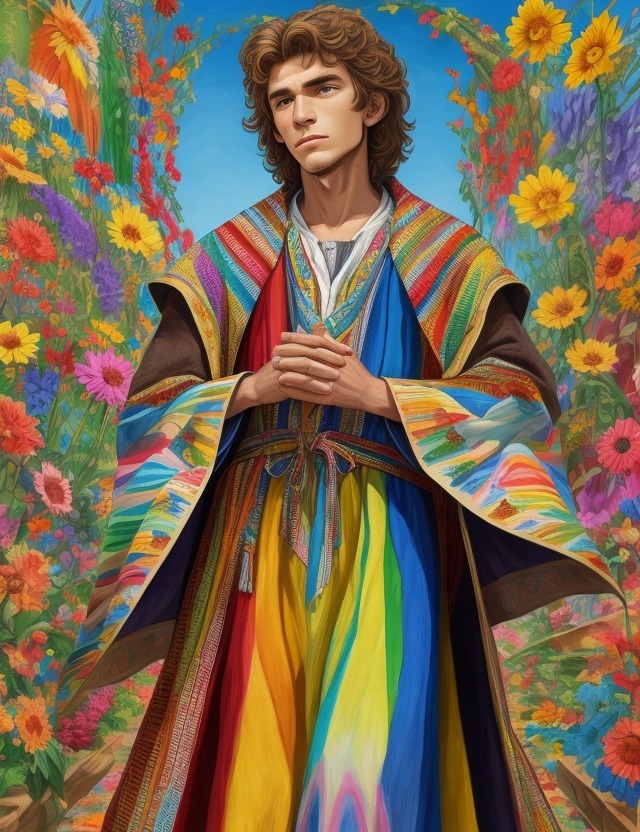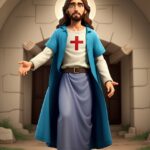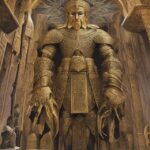Step into a world where vibrant hues intertwine with ancient biblical tales, producing an enduring legacy that has fascinated us for centuries. Explore the enigmatic tapestry of Joseph and his magnificent coat of many colors as we embark on a remarkable journey through time. In this article, we will unravel the hidden narratives, delve into the historic context, and unleash the profound symbolism behind this timeless story authored by generations of dreamers and visionaries.
- Joseph and his coat of many colors Story Summary
- Joseph and his coat of many colors: Key Themes
- Joseph and his coat of many colors: Characters
- Joseph and his coat of many colors: Symbols
- Joseph and the Coat of Many Colors Bible Verse
- What Did Joseph’s Coat of Many Colors Represent?
- Joseph’s Coat of Many Colors Father
- Joseph and the Coat of Many Colors Preschool Moral Lesson
- Why Did Jacob Give Joseph the Coat of Many Colors?
- How Many Colors Did Joseph’s Coat Have?
- FAQs
Have you ever been curious about the origins of Joseph’s captivating coat and the deeper meaning it holds? You’re not alone. Countless seekers, scholars, and storytellers have ventured into the depths of this biblical narrative, yearning to discover its intricate metaphors and compelling lessons that continue to resonate with readers today.
Are you ready? Let’s embark on this enthralling adventure and uncover the hidden treasures woven into the fabric of Joseph and His Coat of Many Colors.
Joseph and his coat of many colors Story Summary
Joseph and the coat of many colors bible story. Once upon a time in the land of Canaan, there lived a young boy named Joseph. Joseph was the favorite son of his father Jacob, and as a symbol of his love, Jacob gave Joseph a beautiful, colorful coat. This coat was unlike any other, made up of various colors, and it made Joseph stand out from his brothers.
Joseph’s brothers, however, grew jealous of their father’s affection towards him. They felt invisible and less loved, and their hearts were filled with resentment. To make matters worse, Joseph had a vivid set of dreams that he would share with his siblings, dreams that seemed to suggest he would one day become a great ruler, having authority over them.
One day, Jacob asked Joseph to check on his brothers who were tending to their flock of sheep. As Joseph approached them wearing his colorful coat, jealousy overtook his brothers, and they devised a wicked plan. They stripped Joseph of his coat and threw him into an empty cistern, intending to leave him there to die.
But then, a group of merchants passing by noticed Joseph’s cries for help, and seeing an opportunity, his brothers decided to sell him as a slave to them. Joseph was taken to Egypt, a land far away from his home, his family, and everything he knew.
In Egypt, Joseph was sold to Potiphar, a high-ranking official in Pharaoh’s court. Despite his misfortune, Joseph’s faith remained unshaken, and he worked diligently for Potiphar. His determination and God’s blessings were evident to everyone around him, and Potiphar quickly recognized Joseph’s talents. He soon put Joseph in charge of his household.
However, Joseph’s journey was not without its trials. Potiphar’s wife, who was infatuated with Joseph’s charm and beauty, tried to seduce him. But Joseph, being a righteous young man, refused her advances, for he knew it was morally wrong. Angered by his rejection, Potiphar’s wife accused Joseph of attempted rape, and he was thrown into prison.
Even in the darkest of times, Joseph remained faithful, and God continued to bless him. In prison, Joseph interpreted the dreams of Pharaoh’s cupbearer and baker, who had been imprisoned alongside him. Joseph revealed that the cupbearer would be restored to his position, but the baker would be executed. These interpretations came true, just as Joseph had said, but sadly, the cupbearer forgot to mention Joseph to Pharaoh.
Years passed, and Pharaoh himself began to have troubling dreams. The cupbearer suddenly remembered Joseph and told Pharaoh about the young Hebrew man who had accurately interpreted his dream. Impressed, Pharaoh summoned Joseph from prison to interpret his dreams.
In Pharaoh’s presence, Joseph interpreted his dreams, revealing that there would be seven years of abundant harvests followed by seven years of severe famine. Joseph suggested that Pharaoh appoint a wise and trustworthy man to manage the food supply during the prosperous years, preparing for the difficult ones.
Recognizing Joseph’s God-given wisdom and discernment, Pharaoh appointed him as the second-in-command, overseeing all the affairs of Egypt. Joseph diligently stored as much grain as his heart desired during the plentiful years, ensuring Egypt would have enough food during the impending famine.
As the famine reached Canaan, Joseph’s family suffered greatly. Jacob, hearing that there was food in Egypt, sent his sons to buy grain. Arriving in Egypt, his sons stood before Joseph, unknowingly seeking provisions from their long-lost brother.
Joseph, now a grown man and unrecognizable to them, tested his brothers to see if they had changed. He accused them of being spies and demanded they return with their youngest brother, Benjamin, to prove their innocence.
Filled with remorse for their past actions and unaware that Joseph understood their conversations, Joseph’s brothers were stricken with guilt. They believed that their current predicament was a punishment from God for selling Joseph into slavery all those years ago.
Eventually, Joseph could no longer contain his emotions and revealed his true identity to his brothers. Overwhelmed with joy and sorrow, he forgave them for their betrayal, assuring them that everything that had transpired had been part of God’s plan to save them all.
Joseph sent his brothers back to Canaan to bring Jacob and their families to Egypt, where they could live in safety and prosperity. The family reunion was one of sheer happiness, as Jacob embraced Joseph, the son he thought he had lost forever.
And so, Joseph’s colorful coat, once a symbol of his father’s love, became a symbol of hope, forgiveness, and the power of God’s providence. It was a reminder to Joseph and his family that even in the face of adversity, love and forgiveness could mend even the deepest wounds.
And they all lived happily ever after.
Joseph and his coat of many colors: Key Themes
The Bible story of Joseph and his coat of many colors is found in the Book of Genesis in the Old Testament of the Bible. It follows the life of Joseph, the favored son of Jacob, and explores various themes such as jealousy, forgiveness, and divine providence.
1. Jealousy: One of the key themes in the story is jealousy, particularly among Joseph’s brothers. Joseph’s father, Jacob, favored him greatly, symbolized by the famous coat of many colors. This preference sparked envy and resentment among Joseph’s brothers. Their jealousy grew to the extent that they plotted against him and ultimately sold Joseph into slavery. The theme of jealousy emphasizes the destructive power of envy and the consequences it can have on relationships and families.
2. Forgiveness: Throughout the narrative, Joseph faces numerous hardships, including being sold into slavery, being falsely accused of a crime, and being imprisoned. However, despite these hardships, Joseph eventually emerges as the ruler of Egypt, second only to Pharaoh. When his brothers come to Egypt seeking food during a widespread famine, Joseph recognizes them, but instead of seeking revenge, he forgives them and reconciles with them. This theme of forgiveness highlights the transformative power of letting go of grudges, showing compassion, and seeking reconciliation.
3. Divine Providence: Another significant theme in the story is divine providence. Joseph’s journey from being sold as a slave to becoming a powerful ruler is depicted as part of God’s plan. God’s hand is evident throughout the narrative, guiding Joseph’s path and using his suffering and struggles as a means of accomplishing God’s greater purposes. This theme reminds readers of the belief that God can work through difficult circumstances to bring about greater good and fulfill His plans for individuals and humanity as a whole.
In conclusion, the story of Joseph and his coat of many colors explores themes of jealousy, forgiveness, and divine providence. It teaches important lessons about the destructive nature of envy, the transformative power of forgiveness, and the belief in God’s guidance and purpose in our lives.
Joseph and his coat of many colors: Characters
1. Joseph:
Joseph is the protagonist of the story, a young man known for his vibrant and colorful coat. He is the favorite son of Jacob, which often leads to jealousy and resentment from his brothers. Joseph is known for his dreams, which he interprets as messages from God. Throughout the story, he displays unwavering faith and resilience, even when faced with adversity and betrayal. His physical appearance is striking, with flowing, lustrous hair, sparkling blue eyes, and a radiant smile that could brighten anyone’s day. Joseph has a peculiar love for animals and can communicate with them effortlessly, a talent that often astounds those around him.
2. Jacob:
Jacob is Joseph’s father and a prominent character in the story. He is a wise and affectionate patriarch, doting on his son Joseph, which often leads to tension with his other children. Jacob has a long, snow-white beard that touches the ground, making him look both grand and a little bit wizard-like. Despite his old age, Jacob possesses a mischievous sense of humor and loves to tell witty jokes and share ancient family stories that always leave his listeners amazed and entertained.
3. The Envious Brothers:
Joseph’s brothers play a crucial role in the story, harboring strong feelings of envy towards their younger sibling. Each brother has distinct physical attributes and personalities. Reuben, the eldest, is tall and muscular, with a booming laugh that echoes through the fields. Simeon and Levi, the next in line, are mischievous twins, causing trouble wherever they go. They have fiery red hair that seems to almost glow in the sunlight. Judah, the fourth brother, is known for his eloquent speeches and deep thinking. He has piercing green eyes that seem to hold a world of secrets. The rest of the brothers, Dan, Naphtali, Gad, Asher, Issachar, Zebulun, Joseph’s full brother Benjamin, and the elder half-brothers Ephraim and Manasseh, possess their own unique traits that contribute to the multifaceted narrative of their relationship with Joseph.
4. Potiphar:
Potiphar, an influential Egyptian official, plays a role in Joseph’s journey. He is a man of commanding stature, with a well-groomed beard that gives an air of authority. Despite his stern appearance, Potiphar has a weakness for Egyptian cotton candy and can’t resist indulging in it whenever it’s offered to him. As Joseph’s master, Potiphar recognizes his extraordinary talent and promotes him to a position of great responsibility.
5. Potiphar’s Wife:
Potiphar’s Wife is a striking beauty, captivating anyone who gazes upon her with her glamorous appearance. She has cascading raven-black hair and eyes that shimmer like the night sky. However, beneath her alluring exterior lies a mischievous spirit that cannot be tamed. Potiphar’s Wife enjoys lighthearted mischief, such as swapping everyday objects with more amusing alternatives to liven up her mundane routine.
6. Pharaoh:
Pharaoh, the ruler of Egypt, is known for his grandeur and regal presence. He is dressed in opulent golden robes adorned with precious jewels, and his crown is so large that it requires a team of attendants to carry it. Despite his extravagant appearance, Pharaoh has an endearing quirk: an uncanny love for his pet hippopotamus, which he insists on taking with him everywhere, much to the confusion and amusement of the royal court.
In the story “Joseph and his coat of many colors,” these characters bring the tale to life with their unique attributes, quirks, and role in shaping Joseph’s extraordinary journey from a beloved son to a revered leader.
Joseph and his coat of many colors: Symbols
1. Coats: One of the most significant symbols in the story of Joseph is his coat of many colors. This garment, symbolizing Joseph’s father’s favoritism towards him, becomes a catalyst for the drama that unfolds in the narrative. It is a visual representation of Jacob’s love for Joseph, and it instigates jealousy and resentment among Joseph’s brothers. The coat not only sets Joseph apart from his siblings but also serves as a target that leads to his eventual sale into slavery.
2. Dreams: Dreams play a crucial role throughout the book of Joseph. Joseph himself is portrayed as a dreamer who receives divine messages through his dreams. His dreams of becoming a ruler and his interpretation of the dreams of Pharaoh and his fellow prisoners contribute to the development of the story. Joseph’s ability to interpret dreams accurately positions him as a pivotal figure in the narrative, ultimately leading to his rise to power in Egypt.
3. Coin: The silver coin that Joseph’s brothers receive for selling him into slavery becomes another significant symbol. The coin represents betrayal and the consequences of jealousy, as it signifies the brothers’ actions and the price they accepted for their actions. Moreover, the coin later becomes the means to identify Joseph when his brothers return to Egypt seeking food during a famine. Joseph deliberately hides the coin in their grain bags, testing their loyalty and challenging them to confront their past sins.
These symbols work together to emphasize the themes of favoritism, betrayal, forgiveness, and divine providence, which are central to the story of Joseph. They also add depth and complexity to the moral and ethical dilemmas faced by the characters, making the story more profound and relatable.
Joseph and the Coat of Many Colors Bible Verse
The story of Joseph with multicolor Coat is found in Genesis 37:3. The verse reads, “Now Israel loved Joseph more than any of his other sons, because he had been born to him in his old age; and he made an ornate robe for him.”
What Did Joseph’s Coat of Many Colors Represent?
The Bible does not specifically state what Joseph’s coat of many colors represented. However, it is believed that the coat was a symbol of Jacob’s favoritism towards Joseph. The coat may have also represented Joseph’s status as the firstborn son of Rachel, whom Jacob loved more than his other wife Leah.
Joseph’s Coat of Many Colors Father
Jacob, also known as Israel, was Joseph’s father. Jacob loved Joseph more than his other sons and made him a coat of many colors.
Joseph and the Coat of Many Colors Preschool Moral Lesson
The moral lesson of the story of Joseph and the Coat of Many Colors is that favoritism can lead to jealousy and conflict. The story teaches us that we should treat all people equally and not show favoritism towards one person over another.
Why Did Jacob Give Joseph the Coat of Many Colors?
The Bible does not specifically state why Jacob gave Joseph the coat of many colors. However, it is believed that the coat was a symbol of Jacob’s favoritism towards Joseph. The coat may have also represented Joseph’s status as the firstborn son of Rachel, whom Jacob loved more than his other wife Leah.
How Many Colors Did Joseph’s Coat Have?
The Bible does not specify how many colors Joseph’s coat had. However, it is believed that the coat was made of many different colors, which is why it is referred to as the “coat of many colors.”
FAQs
1. What is the story of Joseph and his coat of many colors about?
Joseph and his coat of many colors is a popular biblical story from the Book of Genesis. It narrates the journey of Joseph, the 11th son of Jacob, who receives a colorful coat as a gift from his father. The story focuses on Joseph’s dreams, his struggles with his jealous brothers, and his eventual rise to power in Egypt.
2. Why is Joseph’s coat described as of many colors?
The phrase “of many colors” refers to the vibrant and multi-hued coat given to Joseph by his father, Jacob. It symbolizes the special favoritism Jacob had towards Joseph, which further fueled the jealousy of his brothers.
3. What role do dreams play in the story of Joseph and his coat of many colors?
Dreams play a significant role in the story as Joseph has several dreams that foretell his future prominence. One example is the dream in which Joseph’s sheaf of wheat stands upright while his brothers’ sheaves bow down to it. These dreams create tension and intrigue among Joseph’s brothers and eventually lead to events that shape his destiny.
4. How does Joseph end up in Egypt?
Joseph’s brothers, consumed by jealousy and resentment towards him, sell Joseph as a slave to a group of traders. He is then taken to Egypt, where he ultimately becomes an influential figure in Pharaoh’s court, thanks to his ability to interpret dreams.
5. What are the main themes explored in the story of Joseph and his coat of many colors?
The story of Joseph encompasses various themes, including sibling rivalry, forgiveness, divine providence, and the ability to overcome adversity. It also highlights the importance of staying true to one’s beliefs and realizing the power of dreams and their interpretations.










